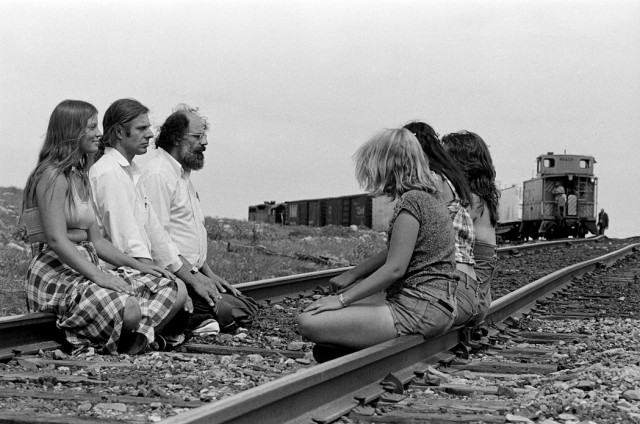
When the 23-year-old Joe Daniel was assigned to cover the Rocky Flats protests in 1978 as a reporter and photojournalist for the Colorado Daily, he didn’t realize the story he was sitting on. He couldn’t foresee that a one-day protest would turn into an anti-nuclear-weapons movement, and that it would result in him publishing not one book, but two.
In Daniel’s re-release of his 1979 book, the newly focused A Year of Disobedience and a Criticality of Conscience not only sheds light on the history of the Rocky Flats protests and the plant’s closure, but compiles the more recent history of the Rocky Flats Wildlife Refuge while citing the value of civil disobedience as an agent for change.
So why, some may ask, is a protest that happened 35 years ago still relevant, especially after the halt of weapons production at the plant in 1989?
“I started thinking, God, I wonder if there is even an anti-nuclear-weapons movement out there?” Daniel says, recalling the active anti-nuclear-weapons movement that was in part catalyzed by the protests at Rocky Flats.
Daniel contacted Daniel Ellsberg, famous releaser of the Pentagon Papers as well as a leader and celebrity voice in the Rocky Flats protests. Ellsberg recently resurfaced in the media in discussions of Bradley Manning and Edward Snowden as whistleblowers like Ellsberg.
“We should reissue this book just to tell the story again, because it’s a remarkable story that 500 people got arrested trying to stop the making of nuclear bomb triggers,” Daniel told Ellsberg, who wrote the initial book preface for the 1979 version. Ellsberg quickly agreed, hoping to bring renewed light to the lingering issues at Rocky Flats.
Joe Daniel | Photo courtesy of Joe Daniel
Daniel also reconnected with LeRoy Moore, a longtime activist who has stayed dedicated to protecting the public from exposure to the contamination at Rocky Flats, now the Rocky Flats Wildlife Refuge.
Like many others, at the time Moore had no idea there was a nuclear bomb plant on the outskirts of Denver. He learned about it through the 1978 occupation of the railroad tracks, and says he realized then that this plant represented all three of the foremost threats to the human race.
“I felt like humans faced the threat of nuclear holocaust, environmental threat or authoritarian government,” says Moore, who contributed to the book’s newest edition. “I haven’t let go of it. … I guess I’m like a doctor that focuses on care of patients: I’m an activist that focuses on concern for other beings.”
Moore says he hopes awareness will be an antidote to public ignorance and indifference.
“My primary concern is public education and creating a record that will endure and inform people in the future,” he says. “We have a responsibility to future generations that I don’t think we’ve responded to well.”
Daniel says he’s worried about the “half-life of awareness,” a term Ellsberg used to refer to the short-lived effectiveness of consciousness as a change agent.
“We tend to have a very short awareness period as humans,” Daniel says. “This happened in ’88 and ’89 when the FBI raid [which ultimately closed Rocky Flats] happened, the reporters covering that made no mention of the demonstrations 10 years earlier.”
Daniel says what draws him back to the subject is the idea of the persistence and courage among people who participate in civil disobedience actions.
“I was fascinated by this idea of civil disobedience, these people that are willing to go out there and put their lives on the line and certainly their possible freedoms,” he says.
The 82-year-old Ellsberg, recently arrested for the 86th time, says he hopes movements like the one at Rocky Flats are not a thing of the past.
“Younger people who have grown up since the Cold War are under the impression that there’s no nuclear problem,” Ellsberg says. “If the situation is going to change, it’s going to have to be this generation that does it. The older generations have succumbed to the belief that the problem has gone away, or they’re just tired.”
With the recent groundbreaking of the Candelas commercial and residential development on the southern border of the Rocky Flats Wildlife Refuge, as well as ongoing talk of the Jefferson Parkway’s construction on the eastern side — a project that would, according to Daniel and Moore, release dangerous plutonium into the air — what role civil disobedience will play in ongoing objections to those projects remains to be seen.
“The establishment is against that change,” Ellsberg says. “Will there be people in Congress who show comparable civil courage to Bradley Manning and Edward Snowden? Unlikely, but possible. And is that enough to stake your life on? Well, for some of us, yes. Even a chance to have some effect in changing the odds and bringing about a better world is worth our individual lives. Without more civil courage we will not survive as a species and, really, young people are the place to look for physical courage and civil courage.”
Respond: [email protected]



